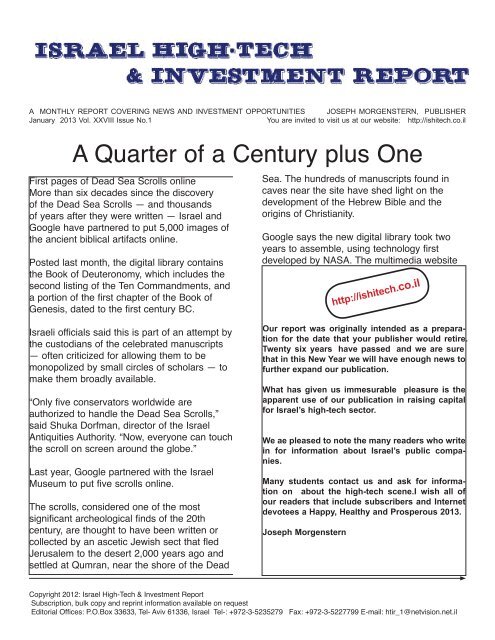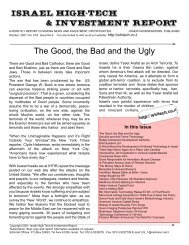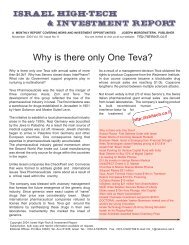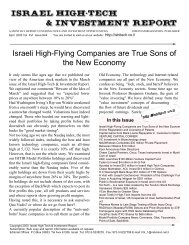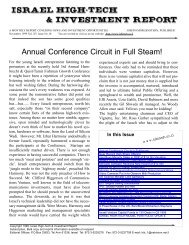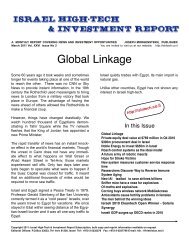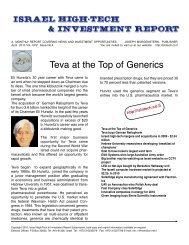A Quarter of a Century plus One - The Israel High Tech & Investment ...
A Quarter of a Century plus One - The Israel High Tech & Investment ...
A Quarter of a Century plus One - The Israel High Tech & Investment ...
You also want an ePaper? Increase the reach of your titles
YUMPU automatically turns print PDFs into web optimized ePapers that Google loves.
A MONTHLY REPORT COVERING NEWS AND INVESTMENT OPPORTUNITIES JOSEPH MORGENSTERN, PUBLISHER<br />
January 2013 Vol. XXVIII Issue No.1 You are invited to visit us at our website: http://ishitech.co.il<br />
A <strong>Quarter</strong> <strong>of</strong> a <strong>Century</strong> <strong>plus</strong> <strong>One</strong><br />
First pages <strong>of</strong> Dead Sea Scrolls online<br />
More than six decades since the discovery<br />
<strong>of</strong> the Dead Sea Scrolls — and thousands<br />
<strong>of</strong> years after they were written — <strong>Israel</strong> and<br />
Google have partnered to put 5,000 images <strong>of</strong><br />
the ancient biblical artifacts online.<br />
Posted last month, the digital library contains<br />
the Book <strong>of</strong> Deuteronomy, which includes the<br />
second listing <strong>of</strong> the Ten Commandments, and<br />
a portion <strong>of</strong> the first chapter <strong>of</strong> the Book <strong>of</strong><br />
Genesis, dated to the first century BC.<br />
Sea. <strong>The</strong> hundreds <strong>of</strong> manuscripts found in<br />
caves near the site have shed light on the<br />
development <strong>of</strong> the Hebrew Bible and the<br />
origins <strong>of</strong> Christianity.<br />
Google says the new digital library took two<br />
years to assemble, using technology first<br />
developed by NASA. <strong>The</strong> multimedia website<br />
http://ishitech.co.il<br />
<strong>Israel</strong>i <strong>of</strong>ficials said this is part <strong>of</strong> an attempt by<br />
the custodians <strong>of</strong> the celebrated manuscripts<br />
— <strong>of</strong>ten criticized for allowing them to be<br />
monopolized by small circles <strong>of</strong> scholars — to<br />
make them broadly available.<br />
“Only five conservators worldwide are<br />
authorized to handle the Dead Sea Scrolls,”<br />
said Shuka Dorfman, director <strong>of</strong> the <strong>Israel</strong><br />
Antiquities Authority. “Now, everyone can touch<br />
the scroll on screen around the globe.”<br />
Last year, Google partnered with the <strong>Israel</strong><br />
Museum to put five scrolls online.<br />
<strong>The</strong> scrolls, considered one <strong>of</strong> the most<br />
significant archeological finds <strong>of</strong> the 20th<br />
century, are thought to have been written or<br />
collected by an ascetic Jewish sect that fled<br />
Jerusalem to the desert 2,000 years ago and<br />
settled at Qumran, near the shore <strong>of</strong> the Dead<br />
Our report was originally intended as a preparation<br />
for the date that your publisher would retire.<br />
Twenty six years have passed and we are sure<br />
that in this New Year we will have enough news to<br />
further expand our publication.<br />
What has given us immesurable pleasure is the<br />
apparent use <strong>of</strong> our publication in raising capital<br />
for <strong>Israel</strong>’s high-tech sector.<br />
We ae pleased to note the many readers who write<br />
in for information about <strong>Israel</strong>’s public companies.<br />
Many students contact us and ask for information<br />
on about the high-tech scene.I wish all <strong>of</strong><br />
our readers that include subscribers and Internet<br />
devotees a Happy, Healthy and Prosperous 2013.<br />
Joseph Morgenstern<br />
Copyright 2012: <strong>Israel</strong> <strong>High</strong>-<strong>Tech</strong> & <strong>Investment</strong> Report<br />
Subscription, bulk copy and reprint information available on request<br />
Editorial Offices: P.O.Box 33633, Tel- Aviv 61336, <strong>Israel</strong> Tel-: +972-3-5235279 Fax: +972-3-5227799 E-mail: htir_1@netvision.net.il
JANUARY 2013<br />
allows users to zoom in on various fragments,<br />
with translations and Google maps alongside.<br />
Google hopes to further expand its project.<br />
Two months ago Google launched a “Cultural<br />
Institute,” a digital visual archive <strong>of</strong> historical<br />
events in co-operation with 17 museums and<br />
institutes around the world.<br />
Cross-browser company Crossrider sold<br />
for $37m.<br />
Cross-browser extension developer Crossrider<br />
Ltd. has been acquired by a foreign Internet<br />
company, whose name has not been disclosed<br />
for $37 million. Crossrider CEO Koby<br />
Menachemi and CTO Shmueli Achdut, who<br />
founded the company in April 2011, and own<br />
more than half <strong>of</strong> it, will make more than $9<br />
million each from the sale.<br />
Crossrider raised $2 million in two financing<br />
rounds from private investors led by Oren<br />
Zeev, and joined by Gigi Levy, Michael<br />
Einsenberg, serial entrepreneur Tal Barmoach,<br />
and others. Menachemi told “Globes”, “<strong>The</strong><br />
investors are making a ten-fold return on their<br />
investment in 16 months. That’s a phenomenal<br />
return. <strong>The</strong>y still feel that there is something<br />
much bigger here, but it was the right decision<br />
to sell.”<br />
As for the decision to sell, Menachemi said,<br />
“We had several <strong>of</strong>fers, even though the<br />
company was not up for sale. <strong>The</strong> potential<br />
is very great and the company has been<br />
pr<strong>of</strong>itable since March, but we weren’t looking<br />
to be sold. We began receiving <strong>of</strong>fers, and we<br />
think we have very strong synergy with the<br />
buyer, and it’s important for us to continue.”<br />
Crossrider will continue to operate<br />
independently with its 18 employees in<br />
Tel Aviv. “We don’t see ourselves leaving<br />
the company in the years ahead,” said<br />
Menachemi.<br />
Crossrider’s platform enables developers to<br />
develop extensions that work on all popular<br />
browsers (Explorer, Chrome, Firefox, and<br />
Safari). 14,000 developers currently use the<br />
platform, and there have been more than 216<br />
million downloads <strong>of</strong> extensions developed<br />
through the platform.<br />
Crossrider’s business model allows free<br />
use <strong>of</strong> the development platform and <strong>of</strong>fers<br />
monetization models for developers and<br />
shares the pr<strong>of</strong>its with them. Menachemi says<br />
that a developer can <strong>of</strong>fer a browser extension<br />
that will open a window when a user looks at<br />
a particular product on Amazon.com and <strong>of</strong>fer<br />
him the product at a cheaper price at another<br />
website. If a sale is made, Crossrider shares in<br />
the revenue.<br />
Menachemi says that the decision to sell<br />
Crossrider at such an early stage was pure<br />
economics, which would benefit the company,<br />
its employees, and investors. “With this sale,<br />
we will reach new heights. I think that the<br />
<strong>Israel</strong> <strong>High</strong>-<strong>Tech</strong> & <strong>Investment</strong> Report<br />
Published monthly since January 1985<br />
Publisher and Editor in Chief<br />
Joseph Morgenstern, B.A. Chem.<br />
<strong>Tech</strong>nology Review Board<br />
Pr<strong>of</strong>. S.J. Joel-Cohen, MD, FRCS. FRCOG (1996-2002)<br />
Pr<strong>of</strong>. Hylton Miller, M.B. Ch.B.<br />
Copy Chief<br />
Debbie Mor<br />
Web Master<br />
Marty vonBokel<br />
Graphics Consultant<br />
Daniel Morgenstern<br />
Subscription Inquiries<br />
Tel-. +972-3-5235279 Fax. +972 3-5227799<br />
E-mail: htir_1@netvision.net.il<br />
Annual subscription $95.- per year, for 11 issues,<br />
<strong>Israel</strong>i residents add 17% VAT<br />
Web Edition and Achives<br />
http://ishitech.co.il<br />
2
JANUARY 2013<br />
buyer made a great deal,” he said.<br />
Menachemi and Achdut met while working<br />
at financial portal Seeking Alpha. <strong>The</strong>y were<br />
introduced by Seeking Alpha CEO David<br />
Jackson, who suggested that they co-found<br />
a venture. Menachemi says that the idea for<br />
Crossrider was developed to meet a personal<br />
need. “I wrote a browser extension for<br />
Chrome to solve a small problem I faced on<br />
it. Within two days, I saw that 30,000 people<br />
had downloaded the extension, so I decided<br />
to adapt it to Firefox and Explorer. But we<br />
realized that this was complicated and took<br />
a long time, so we decided to establish a<br />
platform to facilitate the work,” he said.<br />
Lifewatch Smartphone: <strong>Israel</strong>’s<br />
technological gift to the world<br />
<strong>Israel</strong>i scientists at the Weitzmann University<br />
have invented the world’s first medical<br />
smartphone. <strong>The</strong> technology enables the<br />
user to keep track <strong>of</strong> their own vital signs,<br />
peforming functions similar to those that bulky<br />
medical devices such as intensive care EKG<br />
monitoring machines formerly did.<br />
Functionally, the Lifewatch V replaces within<br />
the Smartphone common medical instruments<br />
such as stethoscopes, thermometers, or<br />
pedometers to provide not only basic task<br />
support such as measuring heart rate,<br />
temperature or daily step counts but a<br />
comprehensive array <strong>of</strong> diagnostic readings<br />
as well. LifeStar ACT Ambulatory Cardiac<br />
Telemetry<br />
Cardiac Arrhythmia Monitoring<br />
Holter Monitoring<br />
Clinical Research Services<br />
LifeWatch Connect EMR Platform<br />
NiteWatch Home Sleep Testing While<br />
individual apps previously have been<br />
developed and currently exist for various<br />
individual tests or groups <strong>of</strong> tests, this is the<br />
first medical all-in-one Smartphone.<br />
Currently an Android-based technology<br />
Lifewatch provides embedded sensors to<br />
measure secondary readings such as blood<br />
glucose and body fat percentage as well as<br />
perform at-home electrocardiograms and blood<br />
pressure readings with the attached sleeve.<br />
Hi-<strong>Tech</strong> Robots<br />
While there is no guarantee that Gilad Shalit<br />
will be the last IDF soldier to be kidnapped and<br />
imprisoned in Gaza, the army has an advantage<br />
today that it didn’t have five years ago, when<br />
Shalit was nabbed: A fully mechanized and<br />
computerized patrol system that can provide full<br />
24/7 coverage <strong>of</strong> events at the border, allowing<br />
soldiers to quickly and efficiently - and safely -<br />
respond to problems. <strong>The</strong> technology for this<br />
sophisticated robotic system was developed<br />
at the Research and Development Institute for<br />
Intelligent Robotic Systems, <strong>of</strong> the Computer<br />
Science Department <strong>of</strong> the College <strong>of</strong> Management<br />
Academic Studies (COMAS) <strong>of</strong> Rishon),<br />
and was visited by some <strong>of</strong> the top robotics<br />
minds from the U.S. visited the College in order<br />
to get a first-hand look at the new technologies<br />
the Institute is creating.<br />
<strong>The</strong> Robotics Institute, among other things,<br />
develops artificial intelligence algorithms for<br />
robots to be used by <strong>Israel</strong>’s military and security<br />
forces, to help guard <strong>Israel</strong>’s borders and<br />
prevent kidnapping <strong>of</strong> soldiers by infiltrators.<br />
Already in production for several years, the<br />
Institute was the brains behind the development<br />
<strong>of</strong> the Genius Robotic Patrol system, which is in<br />
use on the Gaza border, and is produced jointly<br />
by Elbit and <strong>Israel</strong> Aircraft Industries. <strong>The</strong> system<br />
basically replaces infantry and jeep patrols<br />
along the border fence. An unmanned smart<br />
vehicle – controlled from a base station by a live<br />
soldier – follows the border fence road, avoiding<br />
obstacles automatically.<br />
If it detects a problem – a breach in the fence,<br />
or the presence <strong>of</strong> an individual or object that<br />
shouldn’t be there – it immediately transmits<br />
3
JANUARY 2013<br />
pictures and data to the control center. At that<br />
point the soldiers in charge can decide how<br />
to handle the situation; for example, they can<br />
instruct one <strong>of</strong> the fighter pilots in the sky<br />
patrolling the fence area to zero in on the target,<br />
eliminating it. <strong>The</strong> robots actually travel in<br />
a fleet, says Dr. Yehuda Elmaliach, founder<br />
and director <strong>of</strong> the Institute. “This way, the area<br />
is fully covered even when one <strong>of</strong> the robots is<br />
engaged in a specific mission. Another robot<br />
that is part <strong>of</strong> the patrol can take over its duties,<br />
thus preventing the use <strong>of</strong> diversions by terrorists<br />
to get over the border or launch an attack,”<br />
he says. This is the first land-based unmanned<br />
rover used for defense purposes.<br />
<strong>The</strong> visitors, who included 13 university presidents<br />
and pr<strong>of</strong>essors, included some <strong>of</strong> the<br />
leaders in robotics technology in the U.S.<br />
Among the delegation were Leo Morton <strong>of</strong> the<br />
University <strong>of</strong> Missouri, Dr. John L. Anderson<br />
<strong>of</strong> the Illinois Institute <strong>of</strong> <strong>Tech</strong>nology, and Dr.<br />
Gary D. Russi <strong>of</strong> Oakland University. All three<br />
schools have advanced robotics departments,<br />
and have worked on developing defensive<br />
systems for U.S. security services. <strong>The</strong> visitors<br />
were treated to the latest developments in<br />
robotics for security and defense purposes – all<br />
<strong>of</strong> which, says Dr. Elmaliach, can help save the<br />
lives <strong>of</strong> soldiers.<br />
<strong>The</strong> Institute, headed by Dr. Elmaliach, was<br />
founded in 2008 on the initiative <strong>of</strong> Dr.Shmuel<br />
Itzikowitz with the help <strong>of</strong> the parents <strong>of</strong> three<br />
IDF soldiers, Benny Avraham, Adi Avitan and<br />
Omar Souad, who were kidnapped and killed<br />
by Hezbollah in 2000. A son <strong>of</strong> Pr<strong>of</strong>. Itzikowitz<br />
was also in the same unit as the 3 soldiers, and<br />
at Benny Avraham’s request, he had exchanged<br />
places with him and so was on leave when the<br />
attacks took place.<br />
<strong>The</strong> Institute has set itself the goal <strong>of</strong> creating<br />
robot-powered applications for the military and<br />
security forces. It works closely together with<br />
the IDF Engineering Corps on projects to find<br />
technological solutions to prevent the circumstances<br />
facilitating the kidnapping <strong>of</strong> soldiers,<br />
an issue which is still very much on the mind <strong>of</strong><br />
<strong>Israel</strong>is, with the prolonged captivity and recent<br />
release <strong>of</strong> IDF soldier Gilad Shalit. An increasing<br />
amount <strong>of</strong> robotic technology is being<br />
incorporated into militaries and security bodies<br />
around the world. According to the projection<br />
<strong>of</strong> the American FCS (Future Combat Systems),<br />
by the year 2015, one third <strong>of</strong> the US military<br />
will consist <strong>of</strong> unmanned forces (robots).<br />
During the event, Pr<strong>of</strong>. Itzikowitz introduced a<br />
video presentation about the events following<br />
the 2000 kidnappings, and discussed the role <strong>of</strong><br />
Academia in the defense <strong>of</strong> <strong>Israel</strong>. He was joined<br />
by Dr. Elmaliach, an expert in artificial intelligence<br />
and robotics, who discussed the vision<br />
and activities <strong>of</strong> Robots in the Battle Field. In<br />
addition, IDF Colonel (Res.) Lior Lotan, former<br />
commander <strong>of</strong> an elite Special Forces unit, and<br />
one <strong>of</strong> the world’s foremost experts in hostage<br />
situations and hostage negotiations, discussed<br />
the <strong>Israel</strong>i Experience <strong>of</strong> Counter Terrorism –<br />
Understanding the Threats, Counter Strategy,<br />
Tactics and Future Trends. Lotan was awarded<br />
the IDF Chief <strong>of</strong> Staff Medal <strong>of</strong> Honor for his<br />
part in an operation for the attempted release <strong>of</strong><br />
abducted IDF solder Nachshon Waksman and<br />
was in charge <strong>of</strong> the negotiations in which <strong>Israel</strong><br />
received the bodies <strong>of</strong> the 3 soldiers kidnapped<br />
and killed in 2000.<br />
Qualcomm acquires LTE and backhaul solutions<br />
DesignArt Networks<br />
Global wireless technology provider Qualcomm<br />
has acquired DesignArt Networks, a provider <strong>of</strong><br />
small cell modem and system design for cellular<br />
base stations and high-speed wireless backhaul<br />
infrastructure. Terms <strong>of</strong> the deal were not<br />
disclosed. Reportedly, the company was sold<br />
for $120-$140 million.<br />
DesignArt’s system-on-chip (SoC) technology<br />
enables simultaneous operation <strong>of</strong> multiple<br />
4
JANUARY 2013<br />
cellular and backhaul modems with low power<br />
consumption and high throughput. With this<br />
acquisition, Qualcomm adds the DesignArt LTE<br />
and backhaul solutions to its existing portfolio <strong>of</strong><br />
small cell base station technologies and complementary<br />
Wi-Fi, Ethernet and passive optical<br />
networking (PON) connectivity solutions.<br />
“DesignArt and its products will both enhance<br />
and accelerate our initiatives to drive increased<br />
capacity and coverage in mobile networks,”<br />
said Craig Barratt, president <strong>of</strong> Qualcomm<br />
Atheros. “Operators can significantly improve<br />
user experience across residential, enterprise<br />
and outdoor networks given the greater network<br />
efficiencies derived by implementing small cells<br />
and heterogeneous networks.”<br />
DesignArt was founded in August 2006 by Oz<br />
Barak, the company CEO, and Assaf Touboul,<br />
CTO at DesignArt. Based in Ra’anana, <strong>Israel</strong>,<br />
the company investors include, Motorola Ventures,<br />
Carmel Ventures and Magma Venture<br />
Partners.<br />
Digital media company Perion acquires<br />
SweetPacks for $43 million<br />
Digital media company Perion Network (formerly<br />
IncrediMail) has acquired <strong>Israel</strong>i consumer<br />
internet company SweetPacks, for some $43<br />
million in cash and shares.<br />
SweetPacks <strong>of</strong>fers a selection <strong>of</strong> products<br />
designed to enhance the user’s digital experience.<br />
Its SweetIM application allows user<br />
to enhance their messaging experience and<br />
express in creative ways across online platforms<br />
like messenger, Facebook, and email.<br />
“This combination provides meaningful scale<br />
and adds improved back-end systems that<br />
will strengthen our competitive advantage,”<br />
said Josef Mandelbaum, Perion’s CEO. “This<br />
acquisition further accelerates our own efforts<br />
to scale, adds 22 million new users, creating a<br />
larger and more pr<strong>of</strong>itable company.”<br />
“This combination is a unique and powerful<br />
opportunity to leverage the successes <strong>of</strong> both<br />
Perion and SweetPacks,” said SweetPacks’<br />
CEO, Nadav Goshen, who will join Perion as its<br />
new Chief Operating Officer. “I firmly believe in<br />
Perion’s vision for the future and am confident<br />
that together we can accelerate growth and<br />
increase pr<strong>of</strong>itability.”<br />
Founded in 2000, SweetPacks generated $29.7<br />
million in revenues in the 12-month period ending<br />
September 30, 2012, with Adjusted EBITDA<br />
<strong>of</strong> $9.0 million, at a 30% margin. This is 89%<br />
higher than 2011 revenues <strong>of</strong> $15.7 million and<br />
almost double 2011 Adjusted EBITDA <strong>of</strong> $4.5<br />
million.<br />
Perion <strong>of</strong>fers a growing portfolio <strong>of</strong> easy-to-use<br />
products, including: IncrediMail Premium, an<br />
e-mail product sold in over 100 countries in 8<br />
different languages; Smilebox, a photo social<br />
expression product and service; and PhotoJoy,<br />
a photo sharing and discovery screensaver/<br />
wallpaper product.<br />
Founded in 2000, Perion is headquartered in<br />
Redmond, WA, with a research and development<br />
center in Tel Aviv, <strong>Israel</strong>. <strong>The</strong> company<br />
is traded on Nasdaq (PERI) and TASE, with a<br />
market cap <strong>of</strong> $90 million.<br />
EMC buys database monitoring company<br />
More IT<br />
US storage technologies giant EMC Corp.<br />
(NYSE: EMC) has acquired <strong>Israel</strong>i database and<br />
big data performance and monitoring company.<br />
<strong>The</strong> company did not <strong>of</strong>ficially announce the<br />
deal but published the acquisition on an <strong>of</strong>ficial<br />
blog post by its Greenplum division senior director<br />
<strong>of</strong> strategy Mike Maxey. Terms <strong>of</strong> the deal<br />
were not disclosed but market sources believe<br />
that EMC will be paying $10-$20 million.<br />
Based in Bnei Brak, More IT Resources was<br />
founded in 2006 and last year Shachar Efal<br />
5
JANUARY 2013<br />
joined the company as an investor.<br />
This is EMC’s seventh acquisition in <strong>Israel</strong>. It<br />
bought storage systems company XtremIO for<br />
$430 million in May this year.<br />
Objet completes merger and $1.4b exit<br />
<strong>Israel</strong>i 3D printer developer Objet and US rival<br />
Stratasys have now merged into a new <strong>Israel</strong>i<br />
company called Stratasys.<br />
Last weekend it looked like Retalix Ltd. (Nasdaq:<br />
RTLX; TASE: RTLX) acquisition by NCR<br />
at a company value <strong>of</strong> $800 million was going<br />
to be the largest <strong>Israel</strong>i exit <strong>of</strong> 2012. However,<br />
the next day that deal was surpassed. <strong>Israel</strong>i<br />
3D printer manufacturer Objet Ltd. and its US<br />
rival Stratasys Inc. (Nasdaq: SSYS) announced<br />
that their merger has been completed creating<br />
a company with a value <strong>of</strong> $3 billion that will be<br />
incorporated in <strong>Israel</strong>.<br />
<strong>The</strong> two companies first announced the merger<br />
in April 2012. In a reverse merger, the shares <strong>of</strong><br />
the privately held <strong>Israel</strong>i company were merged<br />
with the publicly traded US company to create a<br />
new company, defining itself as <strong>Israel</strong>i but which<br />
will continue to be called Stratasys. Under the<br />
terms <strong>of</strong> the merger, the public will own 55%<br />
<strong>of</strong> the merged company, and the Objet shareholders<br />
will own 45% on a fully diluted basis.<br />
<strong>The</strong> value <strong>of</strong> the merged company last April<br />
amounted to $1.4 billion and because Stratasys<br />
had a former value <strong>of</strong> $766 million, Objet we<br />
can conclude was valued at $634 million.<br />
Meanwhile, seven months have passed and the<br />
value <strong>of</strong> the two companies has risen sharply.<br />
<strong>The</strong> market cap <strong>of</strong> Stratasys during that period<br />
has doubled, both due to its own improved<br />
results and the results <strong>of</strong> the merged company,<br />
and it is now worth $1.6 billion. As the announcement<br />
today says that the new company has a<br />
value <strong>of</strong> $3 billion, this gives Objet a company<br />
value <strong>of</strong> $1.4 billion.<br />
<strong>The</strong> closing value <strong>of</strong> the old Stratasys on Thursday<br />
will be the base for trading in the new share,<br />
and with the number <strong>of</strong> shares <strong>of</strong> the new company<br />
being almost doubled, the company value<br />
will rise by the same multiple. In this way, this<br />
complicated deal creates the largest <strong>Israel</strong>i exit<br />
<strong>of</strong> the year.<br />
Objet CEO David Reis who becomes CEO<br />
<strong>of</strong> the new Stratasys told “Globes,” This is an<br />
exceptional event in <strong>Israel</strong>’s high tech world. It’s<br />
a most abnormal event.”<br />
Stratasys founder and former CEO Scott Crump<br />
becomes chairman <strong>of</strong> the new company. Elhanan<br />
Jaglom, an Objet shareholder and former<br />
chairman becomes chairman <strong>of</strong> the new company’s<br />
management committee. <strong>The</strong> new company,<br />
which to all intents and purposes will be<br />
an <strong>Israel</strong>i company, will operate from Minnesota<br />
and Rehovot.<br />
Reis said that with the merger completed, the<br />
new company will operate on two levels: marketing<br />
and sales, and R&D. “<strong>The</strong> combined<br />
company has a broad portfolio <strong>of</strong> different printers<br />
<strong>of</strong> almost 20 kinds and we hope that this<br />
range will answer the needs <strong>of</strong> the two companies’<br />
customers.<br />
He added that as a result <strong>of</strong> the merger marketing<br />
channels will be doubled. “In addition a<br />
large development body will be created that we<br />
hope can develop new products at more rapid<br />
rate than each company separately.”<br />
<strong>The</strong> new Stratasys will become the world’s<br />
leading company in the field and will serve<br />
all those involved in design in every industry.<br />
“Our customers are shoe companies, medical<br />
companies, companies manufacturing defense<br />
equipment and more.” Before the merger, combined<br />
annual revenue <strong>of</strong> the two companies<br />
was $277 million, Reis said.<br />
6
JANUARY 2013<br />
Stratasys believes that within 18 months <strong>of</strong> the<br />
merger’s completion, annual expenditure will<br />
be reduced by $7-8 million not including $3-4<br />
million less in taxes. <strong>The</strong> new company expects<br />
revenue to grow by at least 20% annually, and<br />
non-GAAP operating pr<strong>of</strong>it <strong>of</strong> between 20% and<br />
25%, and net pr<strong>of</strong>it <strong>of</strong> between 16% and 21%.<br />
<strong>The</strong> new company will have 1,000 employees,<br />
and Reis insists there will be no lay<strong>of</strong>fs. He<br />
said, “We are talking about two companies with<br />
rapid growth and we are hiring more employees<br />
all the time. Each quarter we hire dozens <strong>of</strong><br />
employees.”<br />
Qualcomm acquires LTE and backhaul solutions<br />
DesignArt Networks<br />
Global wireless technology provider Qualcomm<br />
has acquired DesignArt Networks, a provider <strong>of</strong><br />
small cell modem and system design for cellular<br />
base stations and high-speed wireless backhaul<br />
infrastructure. Terms <strong>of</strong> the deal were not<br />
disclosed. Reportedly, the company was sold<br />
for $120-$140 million.<br />
DesignArt’s system-on-chip (SoC) technology<br />
enables simultaneous operation <strong>of</strong> multiple<br />
cellular and backhaul modems with low power<br />
consumption and high throughput. With this<br />
acquisition, Qualcomm adds the DesignArt LTE<br />
and backhaul solutions to its existing portfolio <strong>of</strong><br />
small cell base station technologies and complementary<br />
Wi-Fi, Ethernet and passive optical<br />
networking (PON) connectivity solutions.<br />
“DesignArt and its products will both enhance<br />
and accelerate ourinitiatives to drive increased<br />
capacity and coverage in mobile networks,”<br />
said Craig Barratt, president <strong>of</strong> Qualcomm<br />
Atheros. “Operators can significantly improve<br />
user experience across residential, enterprise<br />
and outdoor networks given the greater network<br />
efficiencies derived by implementing small cells<br />
and heterogeneous networks.”<br />
DesignArt was founded in August 2006 by Oz<br />
Barak, the company CEO, and Assaf Touboul,<br />
CTO at DesignArt. Based in Ra’anana, <strong>Israel</strong>,<br />
the company investors includes, Motorola Ventures,<br />
Carmel Ventures and Magma Venture<br />
Partners.<br />
different languages; Smilebox, a photo social<br />
expression product and service; and PhotoJoy,<br />
a photo sharing and discovery screensaver/<br />
wallpaper product.<br />
Founded in 2000, Perion is headquartering in<br />
Redmond, WA, with a research and development<br />
center in Tel Aviv, <strong>Israel</strong>. <strong>The</strong> company<br />
is traded on Nasdaq (PERI) and TASE, with a<br />
market cap <strong>of</strong> $90 million.<br />
New Arab Hi-<strong>Tech</strong> investment fund<br />
announced<br />
A newly established fund “For Better Future”<br />
(FBF) has raised $10 million to invest in Arab<br />
start-up companies in <strong>Israel</strong>. <strong>The</strong> founder <strong>of</strong><br />
the fund, Naim Musa is also the head <strong>of</strong> Akman<br />
Business Group, which develops trade relations<br />
with Arab companies both in <strong>Israel</strong> and in the<br />
Middle East. In an interview with <strong>The</strong> Marker<br />
Newspaper, Musa said that he represents two<br />
international groups <strong>of</strong> Arab investors and that<br />
the fund is intended to raise an additional $40<br />
million to support its work. “<strong>The</strong> groups investing<br />
in the project view the work <strong>of</strong> Arab engineers<br />
as an opportunity and as unfulfilled potential”.<br />
He added that the fund is intended to supply<br />
companies with working spaces and technological<br />
infrastructure in return for stock investment<br />
in the company. “Our aim is to create a place<br />
that will enable companies to promote their<br />
ideas”, Musa said.<br />
<strong>The</strong> launch <strong>of</strong> the fund was announced two<br />
weeks ago at a press conference in Nazareth.<br />
<strong>The</strong> co-founders <strong>of</strong> the fund are businessmen<br />
Yaqob Bulus, and Izat Dabbah. According to<br />
Musa, Bulus will be responsible for identifying<br />
7
JANUARY 2013<br />
start-ups for potential investment.<br />
<strong>The</strong> hi-tech and entrepreneurship scene in Nazareth<br />
has been flourishing in recent months. In<br />
September, the city hosted a hackathon event<br />
in which 14 teams developed mobile apps for 30<br />
hours. <strong>The</strong> event was sponsored by companies<br />
such as Ts<strong>of</strong>en and Google <strong>Israel</strong>. This weekend,<br />
the city will host the “Start-Up Weekend”.<br />
<strong>The</strong> event will last for 54 hours and will bring<br />
together entrepreneurs who will work on various<br />
hi-tech projects. Start- Up Weekend Nazareth<br />
is organized by Juna Khalili, Sami Abboud and<br />
Bishara Rizk and is sponsored by JVP, CISCO<br />
<strong>Israel</strong>, Google, Mercy Corps, NGT, MEPI, NET-<br />
S<strong>Tech</strong> and the Business Hub in Nazareth.<br />
A history <strong>of</strong> Intel’s R&D in <strong>Israel</strong><br />
<strong>The</strong>re are dozens <strong>of</strong> multinationals with development<br />
centres in <strong>Israel</strong>, but no company has<br />
embraced the idea <strong>of</strong> <strong>Israel</strong>i-based R&D more<br />
than Intel.<br />
With four design centers and two fabrication<br />
plants, Intel is <strong>Israel</strong>’s largest private-sector<br />
employer, with about 8,000 direct workers.<br />
As the biggest tech company in <strong>Israel</strong>, it is<br />
responsible for much <strong>of</strong> the country’s hi-tech<br />
ecosystem, with one out <strong>of</strong> every 10 people in<br />
tech working either directly or peripherally for<br />
projects associated with Intel.<br />
intel haifaIntel’s R&D center in Haifa, <strong>Israel</strong><br />
(Image credit: Intel)<br />
Operating in <strong>Israel</strong> since 1974, some <strong>of</strong> <strong>Israel</strong>’s<br />
most important products were conceived,<br />
designed, and manufactured in <strong>Israel</strong>, according<br />
to Rony Friedman, Intel corporate vice<br />
president and general manager <strong>of</strong> the Intel<br />
Architecture Development Group (IADGz).<br />
“Intel <strong>Israel</strong>’s biggest contribution has been in<br />
the development <strong>of</strong> microprocessors, which<br />
are being used in a wide variety <strong>of</strong> products,<br />
for desktop, mobile, and workstation solutions,”<br />
says Friedman. “We also do work on connectivity<br />
products and security technologies here, as<br />
well as development <strong>of</strong> digital devices.”<br />
Among the technologies recently worked on<br />
by the <strong>Israel</strong>i team are Cedarview, Intel’s new<br />
processor for netbooks, and Cloverview, the<br />
processor that will be used in the new Windows<br />
8 tablets due later this year.<br />
Intel stars<br />
<strong>The</strong> first Intel product to put <strong>Israel</strong> “on the map”,<br />
says Friedman, was Banias, better known as<br />
the Pentium M microprocessor, the microprocessor<br />
introduced in 2003 that arguably kicked<br />
<strong>of</strong>f the notebook era.<br />
Intel shows <strong>of</strong>f 3D Tri-Gate transistors<br />
Another important product that, like Banias, was<br />
conceived, designed, directed and manufactured<br />
in <strong>Israel</strong>, was Merom, the Core-2 notebook<br />
processor heir <strong>of</strong> the Pentium M. Introduced in<br />
2006, Merom was the first Intel technology to<br />
produce a microprocessor for mobile, desktop,<br />
and server products, according to Friedman.<br />
“Merom especially helped boost Intel’s stature<br />
in the server market,” Friedman says.<br />
And <strong>of</strong> course, there are the current Intel stars:<br />
the Sandy Bridge and Ivy Bridge family <strong>of</strong> processors,<br />
all designed, manufactured, and managed<br />
by the <strong>Israel</strong> team.<br />
At a recent press conference, Intel revealed that<br />
Sandy Bridge was responsible for 40 percent <strong>of</strong><br />
the company’s sales worldwide in 2011.<br />
<strong>The</strong> more complicated products get, the more<br />
likely it is that teams from around the Intel world<br />
— notably the US and India, as well as <strong>Israel</strong> —<br />
will be working on products together, Friedman<br />
says.<br />
That appears to be the case with the upcoming<br />
Haswell processors: though they were largely<br />
designed in the US, the 22nm tri-gate 3D transistors<br />
inside them (and which are already<br />
8
JANUARY 2013<br />
in use in Ivy Bridge processors) are made in<br />
<strong>Israel</strong>, at Kiryat Gat’s Fab 28 plant.<br />
“Within five years all <strong>of</strong> the human senses will<br />
be in computers. And, although it appears that<br />
Intel is prepping its fab in Ireland to manufacture<br />
its next-generation 14nm transistors, there<br />
will be plenty <strong>of</strong> action for Intel <strong>Israel</strong>, both in<br />
development and manufacturing.<br />
“We have numerous future technologies that<br />
we are already working on in <strong>Israel</strong>, although <strong>of</strong><br />
course I can’t discuss them, since they haven’t<br />
been announced,” says Friedman.<br />
Some <strong>of</strong> those technologies could include<br />
enhancing video streaming — building on the<br />
Intel WiDi (wireless display) technology developed<br />
by Intel <strong>Israel</strong>; enhanced connectivity<br />
using Thunderbolt (or other connectivity technologies),<br />
also largely developed in <strong>Israel</strong>;<br />
and enhancements to Intel’s security s<strong>of</strong>tware<br />
(Intel’s IPT — Identity Protection <strong>Tech</strong>nology —<br />
was developed in <strong>Israel</strong>).<br />
It could even include new areas that Intel is<br />
apparently exploring, based on recent acquisitions,<br />
such as that <strong>of</strong> navigation s<strong>of</strong>tware maker<br />
Telmap — one <strong>of</strong> several <strong>Israel</strong>i start-ups that<br />
Intel has snapped up in recent years.<br />
Computational intelligence<br />
Or, perhaps, development could focus on the<br />
new field <strong>of</strong> computational intelligence, defining<br />
interactions between humans and computers.<br />
In May, Intel announced that it was establishing<br />
the Collaborative Research Institute for Computational<br />
Intelligence in <strong>Israel</strong>, focusing on<br />
applying machine learning, brain-inspired computation<br />
and advanced computer architecture<br />
to s<strong>of</strong>tware.<br />
“Within five years all <strong>of</strong> the human senses will<br />
be in computers, and in 10 years we will have<br />
more transistors in one chip than neurons in<br />
the human brain,” says Mooly Eden, president<br />
<strong>of</strong> Intel <strong>Israel</strong>. “<strong>The</strong> expectations from the Institute<br />
for Computational Intelligence is that it will<br />
provide a leap forward in research and in ideas<br />
that will be translated into products and applications.”<br />
Whatever the future brings for Intel, its <strong>Israel</strong><br />
facilities will remain a large part <strong>of</strong> the company’s<br />
strategy, according to Friedman: “If Intel<br />
had had any doubts about <strong>Israel</strong>, whether financial,<br />
personnel-oriented, or security-oriented,<br />
they would not have continued to build the company’s<br />
relationship with <strong>Israel</strong>.”<br />
Lifewatch Smartphone<br />
Scientists at <strong>Israel</strong>’s Weitzmann’s Institute<br />
have invented the world’s first medical smartphone.<br />
<strong>The</strong> technology enables the user to<br />
keep track <strong>of</strong> their own vital signs, peforming<br />
functions similar to those that bulky medical<br />
devices such as intensive care EKG monitoring<br />
machines formerly did.<br />
Functionally, the Lifewatch V replaces within the<br />
Smartphone common medical instruments such<br />
as stethoscopes, thermometers, or pedometers<br />
to provide not only basic task support such as<br />
measuring heart rate, temperature or daily step<br />
counts but a comprehensive array <strong>of</strong> diagnostic<br />
readings as well. While individual apps previously<br />
have been developed and currently exist<br />
for various individual tests or groups <strong>of</strong> tests,<br />
this is the first medical all-in-one Smartphone.<br />
Currently an Android-based technology, Lifewatch<br />
provides embedded sensors to measure<br />
secondary readings such as blood glucose and<br />
body fat percentage as well as perform at-home<br />
electrocardiograms and blood pressure readings<br />
with the attached sleeve.<br />
Bringing ads to your phones<br />
Taptica, a year-old company founded by technology<br />
and media entrepreneur Kobi Marenko,<br />
9
JANUARY 2013<br />
positions ads on more than 1,000 applications<br />
and mobile search engines.<br />
Mobile technology (i.e., smartphones and tablets)<br />
is considered one <strong>of</strong> the most promising<br />
fields for advertising. Three years ago, research<br />
company eMarketer forecasted that in the U.S.<br />
alone, where the mobile ad market now fetches<br />
$2.6 billion, is expected to reach a staggering<br />
$11.8 billion by 2016. Experts have also<br />
surmised that by 2013, advertising on mobile<br />
platforms will grow by 100%, and even higher<br />
growth is expected in European countries<br />
including Britain, France and Germany.<br />
It’s no surprise, then, that the past year saw the<br />
birth <strong>of</strong> numerous mobile advertising companies<br />
that focus on ad placement on apps and<br />
sites, and work to optimize their presentation to<br />
consumers. Sizeable mobile advertising firms<br />
like Millenial Media have also unveiled IPOs in<br />
the last year.<br />
Among those firms is Taptica, launched in<br />
January by technology and media entrepreneur<br />
Kobi Marenko. <strong>The</strong> company’s goal, in its own<br />
words, is to “connect advertisers with their most<br />
relevant audiences and help publishers maximize<br />
their full earning potential.”<br />
Unlike Google’s AdMob, which sells ads based<br />
on the cost per click (CPC) model, or cost per<br />
exposure (CPM) model, Taptica relies on cost<br />
per action (CPA). In other words, the advertiser<br />
pays based on the number <strong>of</strong> users who complete<br />
a transaction, such as registering for a<br />
game, or filling out personal details like address<br />
and phone number on a registration form or<br />
providing a credit card number.<br />
A company – for example, a travel agency<br />
or gaming company, or an agency that buys<br />
advertising for them – gets a budget from the<br />
advertiser, and in exchange for that budget it is<br />
obligated to attract as many users as possible<br />
who will download an app, buy a product or perform<br />
some other action after viewing the ad.<br />
Taptica positions ads on more than 1,000 applications<br />
and mobile search engines. <strong>The</strong> company’s<br />
revenue comes from advertisers, who<br />
provide Taptica with about $2-3 per user. To<br />
maximize the number <strong>of</strong> users, Taptica employs<br />
a computerized system it developed itself: Of<br />
several versions <strong>of</strong> a banner ad entered into its<br />
system, Taptica matches the most appropriate<br />
version <strong>of</strong> the ad to the user, based on data<br />
such as that user’s residence, interests (drawn<br />
from patterns <strong>of</strong> behavior using other apps on<br />
the device) and cellular provider (which may<br />
hint variables like socioeconomic status). <strong>The</strong><br />
system also studies a user’s response patterns<br />
and knows when to pull the ad if response rates<br />
are too low.<br />
Taptica’s activities are aimed at the U.S. market,<br />
because, Marenko says, they lead the<br />
global mobile ad market. Combined with Britain,<br />
the U.S. accounts for roughly 60% <strong>of</strong> Google’s<br />
spending on mobile ads. Taptica has about 100<br />
clients, including gaming firms like EA and popular<br />
game developers like FIFA and <strong>The</strong> Sims.<br />
“<strong>The</strong> gaming sector spends the most advertising<br />
money on applications in the U.S.,” says<br />
Marenko. “After gaming comes the tourism sector,<br />
with sites like Booking.com and Hotels.com.<br />
In third place are marketing companies, which<br />
use mobile advertising to <strong>of</strong>fer coupons to its<br />
users. A lot <strong>of</strong> consumer choices are made on<br />
mobile devices, and companies invest in advertising<br />
so that customers can compare prices by<br />
scanning barcodes on their smartphones.”<br />
Google teaming with <strong>Israel</strong>i high-tech startups<br />
<strong>The</strong> international technology giant HAS launched<br />
its “Campus Tel Aviv,” a 1,500 square foot (140<br />
square meter) space that will hold regular<br />
events for local entrepreneurs and <strong>of</strong>fer access<br />
to Google staff and other industry experts.<br />
<strong>The</strong> facility will also host “Launchpad,” a selective,<br />
free two-week boot camp for early stage<br />
10
JANUARY 2013<br />
startups. It plans to help 100 promising <strong>Israel</strong>i<br />
startups there each year.<br />
Google calls the facility an “innovation hub” for<br />
<strong>Israel</strong>’s many startups.<br />
Prime Minister Benjamin Netanyahu attended<br />
Monday’s launch and praised <strong>Israel</strong> as the<br />
“startup nation,” the world’s second largest<br />
center <strong>of</strong> tech startups after Silicon Valley.<br />
“<strong>The</strong> world is flying fast,” he said, “and we’re<br />
leading the way.”<br />
Google started its first Launchpad last year in<br />
London.<br />
Cross-browser company Crossrider sold<br />
for $37m<br />
Cross-browser extension developer Crossrider<br />
Ltd. has been acquired by a foreign Internet<br />
company, whose name has not been disclosed<br />
for $37 million. Crossrider CEO Koby Menachemi<br />
and CTO Shmueli Achdut who founded the<br />
company in April 2011, and own more than half<br />
<strong>of</strong> it, will make more than $9 million each from<br />
the sale.<br />
Crossrider raised $2 million in two financing<br />
rounds from private investors led by Oren Zeev,<br />
and joined by Gigi Levy, Michael Einsenberg,<br />
serial entrepreneur Tal Barmoach, and others.<br />
Menachemi told “Globes”, “<strong>The</strong> investors are<br />
making a ten-fold return on their investment in<br />
16 months. That’s a phenomenal return. <strong>The</strong>y<br />
still feel that there is something much bigger<br />
here, but it was the right decision to sell.”<br />
As for the decision to sell, Menachemi said,<br />
“We had several <strong>of</strong>fers, even though the company<br />
was not up for sale. <strong>The</strong> potential is very<br />
great and the company has been pr<strong>of</strong>itable<br />
since March, but we weren’t looking to be sold.<br />
We began receiving <strong>of</strong>fers, and we think we<br />
have very strong synergy with the buyer, and<br />
it’s important for us to continue.”<br />
Crossrider will continue to operate independently<br />
with its 18 employees in Tel Aviv. “We<br />
don’t see ourselves leaving the company in the<br />
years ahead,” said Menachemi.<br />
Crossrider’s platform enables developers to<br />
develop extensions that work on all popular<br />
browsers (Explorer, Chrome, Firefox, and<br />
Safari). 14,000 developers currently use the<br />
platform, and there have been more than 216<br />
million downloads <strong>of</strong> extensions developed<br />
through the platform.<br />
Crossrider’s business model allows free use <strong>of</strong><br />
the development platform and <strong>of</strong>fers monetization<br />
models for developers and shares the pr<strong>of</strong>its<br />
with them. Menachemi says that a developer<br />
can <strong>of</strong>fer a browser extension that will open a<br />
window when a user looks at a particular product<br />
on Amazon.com and <strong>of</strong>fer him the product at<br />
a cheaper price at another website. If a sale is<br />
made, Crossrider shares in the revenue.<br />
Menachemi says that the decision to sell Crossrider<br />
at such an early stage was pure economics,<br />
which would benefit the company, its<br />
employees, and investors. “With this sale, we<br />
will reach new heights. I think that the buyer<br />
made a great deal,” he said.<br />
Menachemi and Achdut met while working at<br />
financial portal Seeking Alpha. <strong>The</strong>y were introduced<br />
by Seeking Alpha CEO David Jackson,<br />
who suggested that they co-found a venture.<br />
Menachem says that the idea for Crossrider<br />
was developed to meet a personal need. “I<br />
wrote a browser extension for Chrome to solve<br />
a small problem I faced on it. Within two days,<br />
I saw that 30,000 people had downloaded the<br />
extension, so I decided to adapt it to Firefox and<br />
Explorer. But we realized that this was complicated<br />
and took a long time, so we decided to<br />
11
JANUARY 2013<br />
establish a platform to facilitate the work,” he<br />
said.<br />
Lifewatch Smartphone: <strong>Israel</strong>’s <strong>Tech</strong>nological<br />
Gift to the World<br />
<strong>Israel</strong>i scientists at Wetzmann University have<br />
invented the world’s first medical smartphone.<br />
<strong>The</strong> technology enables the user to keep track<br />
<strong>of</strong> their own vital signs, peforming functions<br />
similar to those that bulky medical devices such<br />
as intensive care EKG monitoring machines<br />
formerly did.<br />
Functionally, the Lifewatch V replaces within<br />
the Smartphone common medical instruments<br />
such as stethoscopes, thermometers, or<br />
pedometers to provide not only basic task support<br />
such as measuring heart rate, temperature<br />
or daily step counts but a comprehensive array<br />
<strong>of</strong> diagnostic readings as well. While individual<br />
apps previously have been developed and<br />
currently exist for various individual tests or<br />
groups <strong>of</strong> tests, this is the first medical all-inone<br />
Smartphone.<br />
Currently an Android-based technology, Lifewatch<br />
provides embedded sensors to measure<br />
secondary readings such as blood glucose<br />
and body fat percentage as well as perform athome<br />
electrocardiograms and blood pressure<br />
readings with the attached sleeve.<br />
NICE Systems launches voice fraud solution<br />
<strong>The</strong> system includes non-intrusive voice biometrics<br />
technology, speech and transactional<br />
analytics, and real-time capabilities.<br />
NICE Systems Ltd. (Nasdaq: NICE; TASE:<br />
NICE) today announced the launch <strong>of</strong> its Contact<br />
Center Fraud Prevention solution. <strong>The</strong><br />
system tracks fraud patterns and screens all<br />
phone interactions for fraud against a watch<br />
list <strong>of</strong> known fraudsters. <strong>The</strong> solution brings<br />
together the extensive expertise <strong>of</strong> NICE’s<br />
Actimize unit’s in fraud with its years <strong>of</strong> experience<br />
in the contact center. NICE said that the<br />
solution could be deployed as a standalone<br />
contact center solution or as part <strong>of</strong> the NICE<br />
Actimize enterprise fraud system.<br />
NICE explained that organizations will be able<br />
reduce fraud-related losses without creating<br />
service hurdles or compromising the customer’s<br />
experience by adopting a multi-layered<br />
approach. This includes non-intrusive voice biometrics<br />
technology, speech and transactional<br />
analytics, and real-time capabilities.<br />
NICE cites claims by Aite Group claims that<br />
fraud in contact centers is on the rise and, while<br />
many businesses have recognized the need<br />
to protect customer data and secure online<br />
transactions, the phone channel has become<br />
a target for fraud. Datamonitor estimates that<br />
20% <strong>of</strong> people who are defrauded will leave the<br />
institution at which this occurred.<br />
NICE Enterprise Group president Yochai Rozenblat<br />
said, “<strong>The</strong> contact center is a prime target<br />
for fraudsters and enterprises must be prepared<br />
to ensure that this area <strong>of</strong> their business is as<br />
well protected as online transactions. By leveraging<br />
our contact center best practices with<br />
our fraud prevention practice, we were able to<br />
create an end-to-end solution that <strong>of</strong>fers proactive<br />
fraud detection, real-time guidance, and<br />
integrated fraud case management. We believe<br />
that our advanced fraud prevention technology<br />
will help businesses boost their reputations,<br />
protect their customer base, and significantly<br />
reduce fraud losses.”<br />
<strong>Israel</strong>’s arms exports increased by 20 percent<br />
in 2012<br />
Military exports have fluctuated widely in recent<br />
years, peaking at around $7 billion in 2009-<br />
2010. <strong>Israel</strong> is ranked between fourth and sixth<br />
12
JANUARY 2013<br />
in the world for weapons sales.<br />
Advanced <strong>Israel</strong> Military Industries weapons<br />
systems<br />
Advanced <strong>Israel</strong> Military Industries weapons<br />
systems Photo<br />
Defense equipment exports for 2012 are<br />
believed to have reached $7 billion, a 20 percent<br />
increase compared with 2011, according<br />
to preliminary Defense Ministry estimates. Final<br />
figures will be available in March.<br />
Military exports have fluctuated widely in recent<br />
years, and peaked at around $7 billion in 2009-<br />
2010. <strong>Israel</strong> is ranked between fourth and sixth<br />
in the world for weapons sales.<br />
<strong>Israel</strong> exports most <strong>of</strong> its weapons to the United<br />
States and Europe, followed by Southeast Asia<br />
and South America. Export to African countries<br />
is marginal.<br />
Part <strong>of</strong> the last year’s rise in exports stems<br />
from a $1 billion arms deal with Italy. <strong>Israel</strong> is<br />
buying new training jets from the Air Force from<br />
Italy, which has undertaken a mutual procurement<br />
contract - to purchase goods in like value<br />
from <strong>Israel</strong>. Italy’s purchases in <strong>Israel</strong> include<br />
unmanned aerial vehicles.<br />
At a meeting <strong>of</strong> ministry staff last week, Defense<br />
Ministry director general Udi Shani said the ministry<br />
anticipates an increase in weapons sales<br />
to Azerbaijan, Poland, Vietnam and Brazil this<br />
year.<br />
Advancing weapons exports is a major goal for<br />
the ministry, Shani said. Apart from strengthening<br />
the IDF - by reducing production costs <strong>of</strong><br />
local systems bought by the army - it contributes<br />
to the economy as a whole, he said.<br />
<strong>Israel</strong>’s export <strong>of</strong> weapons is increasing at a<br />
time <strong>of</strong> a global economic crisis that has led<br />
numerous states to reduce weapons purchases<br />
since 2008. <strong>The</strong> crisis may become more acute<br />
in view <strong>of</strong> the United States’ planned cutbacks<br />
in the defense budget this year.<br />
This is expected to have indirect repercussions<br />
on <strong>Israel</strong>; because reducing the contracts with<br />
the administration will force the American industries<br />
to seek other markets abroad, increasing<br />
the competition with <strong>Israel</strong>’s defense industry.<br />
<strong>The</strong> Defense Ministry’s goal is to export $10 billion<br />
worth <strong>of</strong> weapons a year within a few years.<br />
Ministry <strong>of</strong>ficials hope to achieve this goal by<br />
increasing the investment and aid to small<br />
and medium defense industries, whose market<br />
share is now quite low.<br />
Ministry sources said all <strong>Israel</strong>’s weapon-export<br />
deals are carried out with the Foreign Ministry’s<br />
approval. Also, <strong>Israel</strong> would not permit exporting<br />
weapons to states that violate human rights,<br />
they said.<br />
$5.5b in <strong>Israel</strong>i exits in 2012<br />
2012 was a record year exits by <strong>Israel</strong>i companies,<br />
pwc <strong>Israel</strong> said today. It reports that exits<br />
by high-tech companies totaled $5.5 billion in<br />
2012, the second highest year, after the $10<br />
billion in 2006.<br />
PwC <strong>Israel</strong> said that the figure does not include<br />
the acquisition <strong>of</strong> NDS Ltd. by Cisco Systems<br />
Inc. (Nasdaq: CSCO), because NDS is not an<br />
<strong>Israel</strong>i company, or the merger <strong>of</strong> Objet Ltd.<br />
with Stratasys Inc. (Nasdaq: SSYS). If counted,<br />
these two transactions would have added $5.7<br />
billion to the 2012 exit total.<br />
According to PwC <strong>Israel</strong>, the average exit transaction<br />
in 2012 was $111 million, the highest figure<br />
since 2005. <strong>The</strong>re were 50 exits altogether.<br />
A breakdown by industry shows that the largest<br />
number <strong>of</strong> acquisitions was in IT and enterprise<br />
13
JANUARY 2013<br />
s<strong>of</strong>tware, amounting to $1.8 billion altogether.<br />
<strong>The</strong> biggest deal was the acquisition <strong>of</strong> XtremIO<br />
by EMC Corporation (NYSE: EMC) for $430<br />
million.<br />
Exits in the life sciences industry totaled $1.28<br />
billion in 2012, and exits in the telecommunications<br />
industry totaled $1.12 billion. <strong>The</strong> Internet<br />
lagged, with $554 million in exits.<br />
“<strong>The</strong> Carlsabad desalination project is an important<br />
milestone for us, for the State <strong>of</strong> California,<br />
and for the US in general. We believe that it will<br />
pave the way for the future <strong>of</strong> desalination in<br />
America,” said IDE president and CEO Avshalom<br />
Felber.<br />
PwC <strong>Israel</strong> partner, <strong>High</strong> <strong>Tech</strong> Assurance Practice,<br />
Rubi Suliman said, “<strong>The</strong> starting point<br />
for 2013 has all the necessary components to<br />
exceed 2012. Furthermore, we believe that we<br />
will also see a bunch <strong>of</strong> interesting IPOs by<br />
<strong>Israel</strong>i companies.”<br />
IDE wins desalination contracts worth $650m<br />
in US<br />
<strong>The</strong> Delek and <strong>Israel</strong> Chemicals joint venture<br />
will supply design and supply equipment for the<br />
Carlsabad desalination plant in San Diego, and<br />
operate it for 30 years.<br />
IDE <strong>Tech</strong>nologies Ltd., owned in equal shares<br />
by Delek Group Ltd. (TASE: DLEKG) and<br />
<strong>Israel</strong> Chemicals Ltd. (TASE: ICL), has signed<br />
a $150 million contract with one <strong>of</strong> the largest<br />
desalination ventures in the US to plan and<br />
supply equipment for the largest desalination<br />
plant in the country. <strong>The</strong> plant will be built near<br />
the Encina power station in Carlsabad, in San<br />
Diego County, California.<br />
IDE has also signed a $500 million, 30-year<br />
operating and maintenance contract with Poseidon<br />
Resources LP for the desalination facility,<br />
which will produce up to 200,000 cubic meters<br />
<strong>of</strong> drinking water a day in 2016. <strong>The</strong> Carslabad<br />
desalination plant will produce 7% <strong>of</strong> the area’s<br />
water consumption by 2020.<br />
Please enroll me as a subscriber to the<br />
<strong>Israel</strong> <strong>High</strong>-<strong>Tech</strong> & <strong>Investment</strong> Report.<br />
I understand that if not satisfied, I may cancel my<br />
subscription at any time and receive a refund <strong>of</strong><br />
the unexpired portion. I enclose a check for $95 (or<br />
the <strong>Israel</strong>i shekel equivalent and 18% v.a.t.) and am<br />
sending it to POB 33633, Tel--Aviv 61336.<br />
I am providing you with my name, title, mailing<br />
address,e-mail, tele<br />
<strong>The</strong> <strong>Israel</strong> <strong>High</strong>-<strong>Tech</strong> & <strong>Investment</strong> Report is a monthly report dealing with news, developments and investment opportunities in the<br />
universe <strong>of</strong> <strong>Israel</strong>i technology and business. While effort is made to ensure the contents’ accuracy, it is not guaranteed. Reports<br />
about public companies are not intended as promotion <strong>of</strong> shares, nor should they be construed as such.<br />
14


